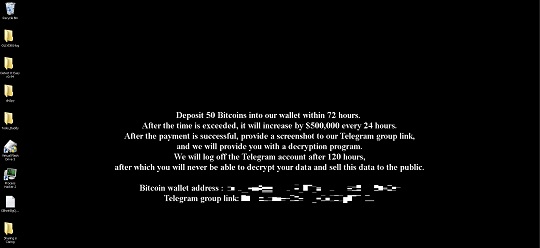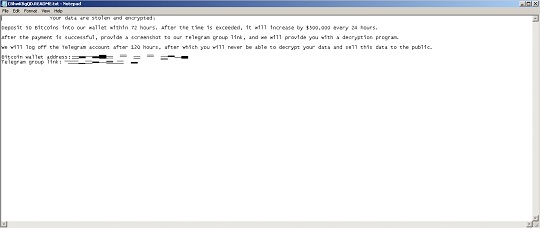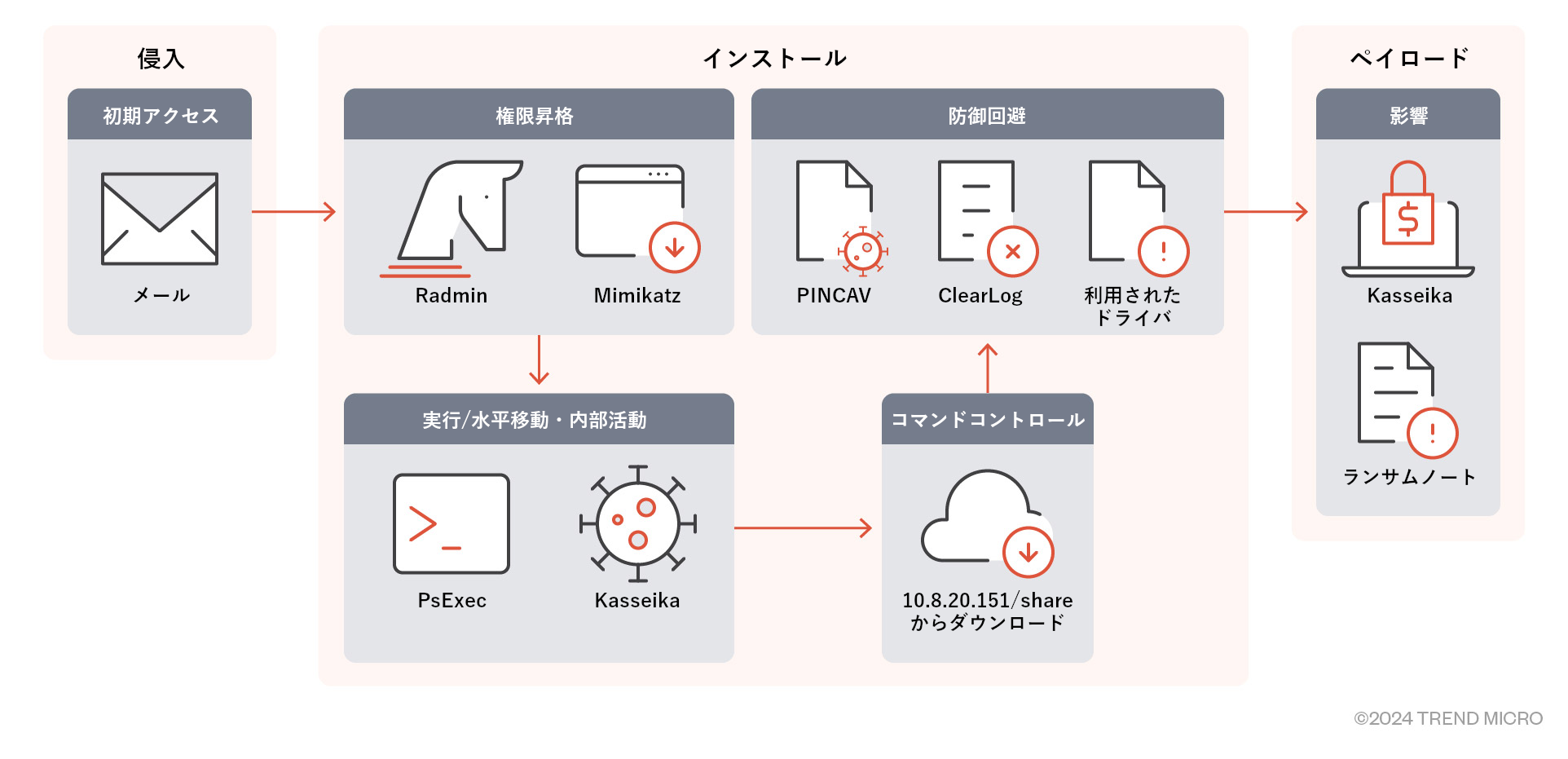Ransom.Win32.KASSEIKA.YPDLDT
Windows


Threat Type: Ransomware
Destructiveness: No
Encrypted: Yes
In the wild: Yes
OVERVIEW
This Ransomware arrives on a system as a file dropped by other malware or as a file downloaded unknowingly by users when visiting malicious sites.
It drops files as ransom note. It avoids encrypting files with the following file extensions.
TECHNICAL DETAILS
Arrival Details
This Ransomware arrives on a system as a file dropped by other malware or as a file downloaded unknowingly by users when visiting malicious sites.
Installation
This Ransomware terminates itself if it finds the following processes in the affected system's memory:
- ntice.sys
- iceext.sys
- Syser.sys
- HanOlly.sys
- extrem.sys
- FRDTSC.SYS
- fengyue.sys
- Kernel Detective
- CisUtMonitor
- FileMonitor.sys
- REGMON
- regsys
- sysregm
- PROCMON
- Revoflt
- Filem
Other System Modifications
This Ransomware sets the system's desktop wallpaper to the following image:
- %Program Data%\CBhwKBgQD.bmp
- %All Users Profile%\CBhwKBgQD.bmp

It uses Windows Management Instrumentation (WMI) to delete volume shadow copies:
- SELECT * Win32_ShadowCopies
Other Details
This Ransomware does the following:
- It terminates itself if found the following window name in the affected system:
- OLLYDBG
- GBDYLLO
- pediy06
- RegmonClass
- Registry Monitor - Sysinternals: www.sysinternals.com
- 18467-41
- FilemonClass
- File Monitor - Sysinternals: www.sysinternals.com
- PROCMON_WINDOW_CLASS
- Process Monitor - Sysinternals: www.sysinternals.com
- It attempts to terminate running processes using the Restart Session Manager to encrypt the associated file as such will result to the following registry modification:
- RegKey: HKEY_CURRENT_USER\Software\Microsoft\RestartManager\Session{numbers}
Owner = {hex values} - RegKey: HKEY_CURRENT_USER\Software\Microsoft\RestartManager\Session{numbers}
SessionHash = {hex values} - RegKey: HKEY_CURRENT_USER\Software\Microsoft\RestartManager\Session{numbers}
Sequence = 0x01 - RegKey: HKEY_CURRENT_USER\Software\Microsoft\RestartManager\Session{numbers}
RegFiles{numbers} = {encrypted path andfile} - RegKey: HKEY_CURRENT_USER\Software\Microsoft\RestartManager\Session{numbers}
RegFilesHash = {hex values}
- RegKey: HKEY_CURRENT_USER\Software\Microsoft\RestartManager\Session{numbers}
- It reads the following registry keys to check for the BIOS version of the affected system:
- HKEY_LOCAL_MACHINE\HARDWARE\DESCRIPTION\System\SystemBiosVersion
- HKEY_LOCAL_MACHINE\HARDWARE\DESCRIPTION\System\VideoBiosVersion
Ransomware Routine
This Ransomware avoids encrypting files with the following strings in their file name:
- autorun.inf
- boot.ini
- bootfont.bin
- bootsect.bak
- d3d9caps.dat
- desktop.ini
- GDIPFONTCACHEV1.DAT
- iconcache.db
- ntldr
- ntuser.dat
- ntuser.dat.log
- ntuser.ini
- thumbs.db
It avoids encrypting files with the following strings in their file path:
- $recycle.bin
- $windows.~bt
- $windows.~ws
- all users
- boot
- config.msi
- default
- intel
- microsoft
- msocache
- perflogs
- program files
- program files (x86)
- programdata
- public
- system volume information
- tor browser
- windows
- windows.old
It appends the following extension to the file name of the encrypted files:
- {original filename}.{original extension}.CBhwKBgQD
It drops the following file(s) as ransom note:
- {encrypted directory}\CBhwKBgQD.README.txt

It avoids encrypting files with the following file extensions:
- 386
- adv
- ani
- bat
- bin
- cab
- cmd
- com
- cpl
- cur
- deskthemepack
- diagcab
- diagcfg
- diagpkg
- dll
- drv
- exe
- hlp
- hta
- icl
- icns
- ico
- ics
- idx
- key
- ldf
- lnk
- lock
- mod
- mpa
- msc
- msi
- msp
- msstyles
- msu
- nls
- nomedia
- ocx
- pdb
- prf
- ps1
- rom
- rtp
- scr
- search-ms
- shs
- spl
- sys
- theme
- themepack
- wpx
SOLUTION
Step 1
Trend Micro Predictive Machine Learning detects and blocks malware at the first sign of its existence, before it executes on your system. When enabled, your Trend Micro product detects this malware under the following machine learning name:
- Troj.Win32.TRX.XXPE50FFF075
Step 2
Before doing any scans, Windows 7, Windows 8, Windows 8.1, and Windows 10 users must disable System Restore to allow full scanning of their computers.
Step 3
Note that not all files, folders, and registry keys and entries are installed on your computer during this malware's/spyware's/grayware's execution. This may be due to incomplete installation or other operating system conditions. If you do not find the same files/folders/registry information, please proceed to the next step.
Step 4
Restart in Safe Mode
Step 5
Delete this registry key
Important: Editing the Windows Registry incorrectly can lead to irreversible system malfunction. Please do this step only if you know how or you can ask assistance from your system administrator. Else, check this Microsoft article first before modifying your computer's registry.
- In RegKey: HKEY_CURRENT_USER\Software\Microsoft\RestartManager\Session{numbers}
- SessionHash = {hex values}
- SessionHash = {hex values}
- In RegKey: HKEY_CURRENT_USER\Software\Microsoft\RestartManager\Session{numbers}
- Sequence = 0x01
- Sequence = 0x01
- In RegKey: HKEY_CURRENT_USER\Software\Microsoft\RestartManager\Session{numbers}
- RegFiles{numbers} = {encrypted path and file}
- RegFiles{numbers} = {encrypted path and file}
- In RegKey: HKEY_CURRENT_USER\Software\Microsoft\RestartManager\Session{numbers}
- RegFilesHash = {hex values}
- RegFilesHash = {hex values}
Step 6
Search and delete these files
- {encrypted directory}\CBhwKBgQD.README.txt
- %Program Data%\CBhwKBgQD.bmp
- %All Users Profile%\CBhwKBgQD.bmp
Step 7
Restart in normal mode and scan your computer with your Trend Micro product for files detected as Ransom.Win32.KASSEIKA.YPDLDT. If the detected files have already been cleaned, deleted, or quarantined by your Trend Micro product, no further step is required. You may opt to simply delete the quarantined files. Please check this Knowledge Base page for more information.
Step 8
Restore encrypted files from backup.
Did this description help? Tell us how we did.


